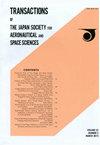Study on the Ignition Method for n-Octane Pyrolysis Fuel in a Scramjet Engine
IF 0.8
4区 工程技术
Q4 ENGINEERING, AEROSPACE
Transactions of the Japan Society for Aeronautical and Space Sciences
Pub Date : 2022-01-01
DOI:10.2322/tjsass.65.33
引用次数: 2
Abstract
In scramjet engines, ignition must take place within a residence time on the order of milliseconds. In this study, secure ignition conditions for speci fi ed n-octane pyrolysis fuel components used in autoignition or forced-ignition by plasma jet torch in a high-speed fl ow were numerically investigated. First, the ignition delay time within the combustor and cavity fl ame-holder was estimated using chemical reaction analysis. Three fuel components (n-C 8 H 18 , all pyrolysis fuel (15 components, decomposition rate under 11%)), and pyrolysis gas fuel (eight gas fuel components, decomposition rate under 11%) could not self-ignite within the combustor and cavity residence time. Secondly, ignition using a plasma jet torch in the cavity was numerically investigated. In the case of forced-ignition by plasma jet torch, all pyrolysis fuel (No. 3) and n-C 8 H 18 could ignite within the cavity residence time with less input energy than pyrolysis gas fuel (No. 3) under three kinds of Mach number fl ight conditions ( M 0 = 4, 6, and 8). Moreover, the e ff ect of shortening the ignition delay time by raising the plasma jet torch gas temperature and O radical rate within the cavity was investigated. Ignition of the three kinds of mixture fuel was more greatly a ff ected by the torch injection temperature than the O radical rate in the cavity under all Mach number fl ight conditions.正辛烷热解燃料在超燃冲压发动机中的点火方法研究
在超燃冲压发动机中,点火必须在毫秒量级的停留时间内进行。本文对特定正辛烷热解燃料组分在高速流动中用于等离子体喷枪自燃或强制点火的安全点火条件进行了数值研究。首先,利用化学反应分析方法估算了燃烧室和空腔火焰架内的点火延迟时间。3种燃料组分(n- c8h18,均为热解燃料(15种组分,分解率在11%以下))和热解气体燃料(8种气体燃料组分,分解率在11%以下)在燃烧室和空腔停留时间内均不能自燃。其次,对等离子体喷枪在腔内点火进行了数值研究。等离子体射流的强制点火火炬,所有裂解燃料(3号)和c 8 H 18可能点燃腔内停留时间减少输入能量比热解气体燃料(3号)三种马赫数fl的洞察力的条件下(M 0 = 4、6和8)。此外,缩短点火延迟时间的e ff等通过提高等离子体射流火炬气腔内的温度和O激进率调查。在所有马赫数飞行条件下,三种混合燃料的点火受喷枪喷射温度的影响大于受腔内O自由基速率的影响。
本文章由计算机程序翻译,如有差异,请以英文原文为准。
求助全文
约1分钟内获得全文
求助全文
来源期刊
CiteScore
1.80
自引率
0.00%
发文量
18
审稿时长
>12 weeks
期刊介绍:
Information not localized

 求助内容:
求助内容: 应助结果提醒方式:
应助结果提醒方式:


